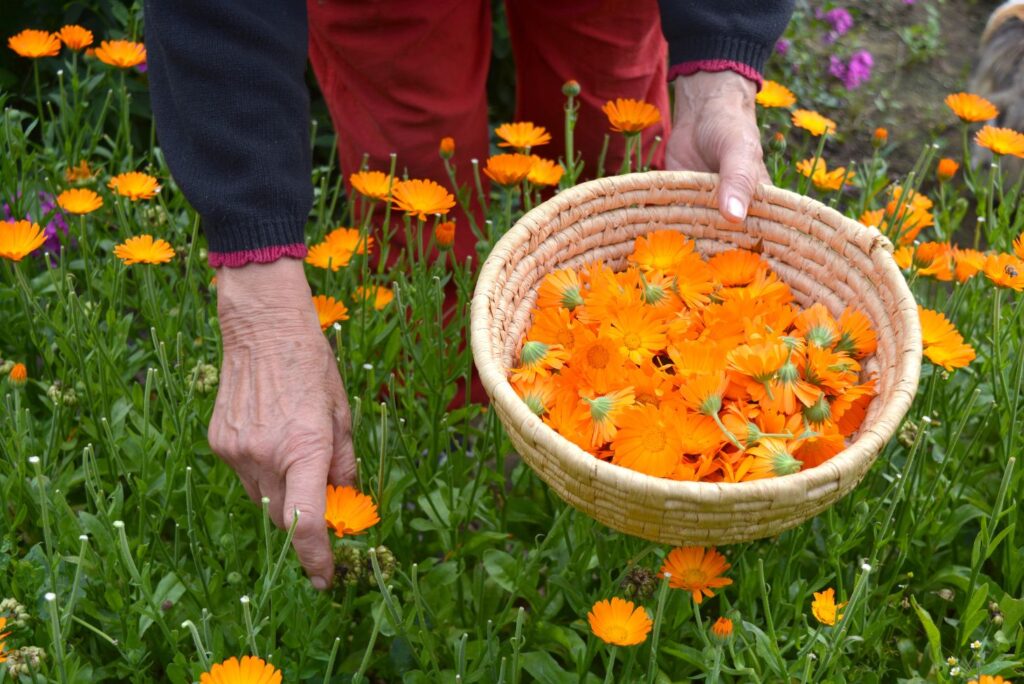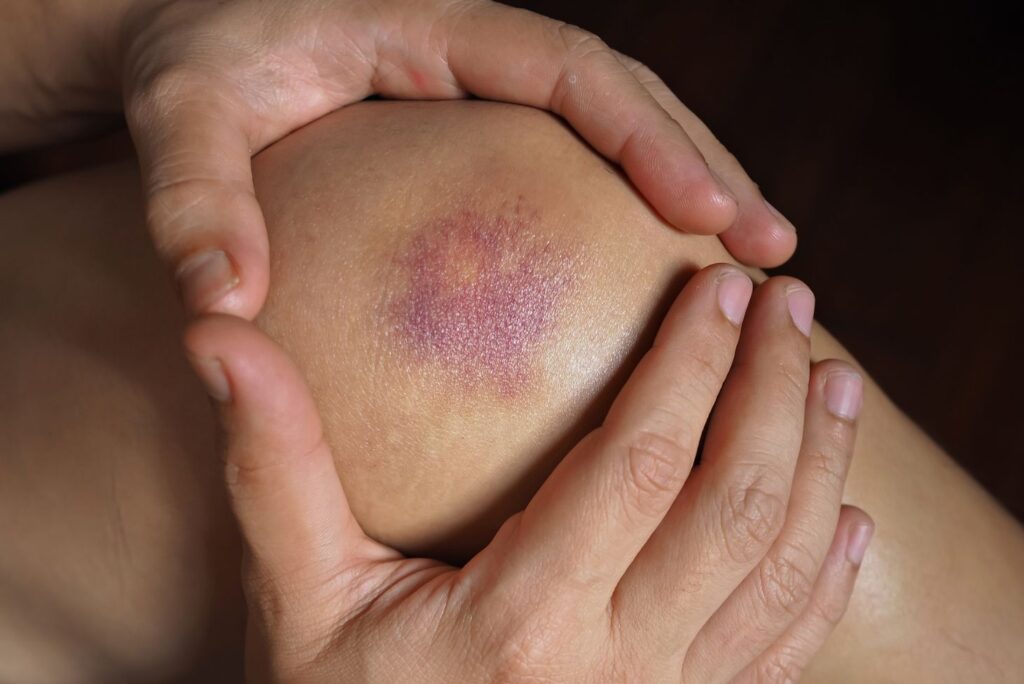Want to learn how to make calendula salve and how to use calendula salve at home? Below is the original calendula salve recipe.
Calendula salve is good for treating minor ailments and for maintaining the health of the skin. Calendula salve, either prepared at home or bought from a natural health food store, can be safely used in almost all skin conditions. But before we show you exactly how to make calendula salve at home and what to use it for, here is how to harvest calendulas to prepare this heal-all ointment.

In This Article You Will Find:
How to Harvest Calendula for Salve
Calendulas, also known as marigolds, bloom from May to September, when they can be harvested to make salves, tinctures, teas, and more. For medicinal preparations with calendula, use only the orange kind of calendula, as the yellow varieties have little to no therapeutic effect. Harvest only the flowers, and pick them by hand, on dry and sunny days. To make calendula salve, you need freshly picked calendula flowers, but you can also dry them for other medicinal recipes, such as tea or tincture.

How to Make Calendula Salve – Original Recipe
Ingredients
- 7 tbsp butter
- 3 tbsp fresh calendula flowers, finely chopped
- 1 tsp wildflower honey (solid)
- 1 tsp bees wax
How to Make
First, melt the butter in a saucepan on low heat, until it liquifies, then add the finely chopped calendulas, honey, and wax. Continue to heat up the ingredients on low heat for 10 minutes, and mix until they dissolve and combine completely. Turn the heat off, and allow the salve to cool a bit. While it is still warm, strain the calendula salve through a clean strainer or a cheesecloth and pour it into a glass jar. Seal the jar and keep it in the refrigerator, where it can be stored for up to three months. Do not use the calendula salve on open wounds!

What Is Calendula Salve Good For
1. Skin Injuries Caused by Radiotherapy
A French study carried out between 1999 and 2001 verified the effects of calendula ointment on 254 patients undergoing radiotherapy after breast cancer surgery. The study concluded that the patients using calendula salve three times a day had significantly smaller skin lesions in size and frequency, had less pain, tolerated the radiotherapy treatment better, and discontinued it in a much lower percentage than those who used the classic trolamine ointment.
2. Varicose Ulcer & Wounds that Are Difficult to Heal
The German Commission “E”, responsible for the approval of the use of natural products in therapy, has concluded that sterile calendula tincture and calendula salve are very effective for the treatment of these ailments. To prevent infection and the expansion of varicose ulcers, wash with calendula tea and apply a calendula tincture compress on the wounds. The calendula salve is used long-term, until complete healing.
3. Contusions & Bruises
In the first 36 hours after bruising, apply compresses with calendula tincture on the affected area, which are kept as long as possible. In the following days, apply calendula salve at least three times a day. This will shorten the healing time, and the contusion will be less obvious and less painful.

4. Cracked Nipples from Breastfeeding
Anoint the breasts, especially the nipple area, with calendula salve after each breastfeeding. This simple treatment has great therapeutic value, as it prevents breast cracks and inflammation, as well as nipple infections, and relieves possible breast pain that occurs during breastfeeding.
5. Skin Depigmentation
Calendula salve applied twice a day helps to regain normal skin pigmentation, after contact with chemical substances or radiation, which can cause spotting on the skin.
Two Alternatives to Calendula Salve for Topical Use
Calendula oil and calendula poultice are two alternatives to calendula salve, which can be used successfully for some skin problems, as follows. First, let’s see how to make marigold oil and what it can be used for.
Put 10 tablespoons of dried and crushed marigold flowers in half a liter of olive, grape seed, or sesame oil in a glass jar. Seal and leave to soak in the sun for 2 weeks, then strain, and pour the infused oil into an amber bottle. Keep in a dark and cool place. Calendula oil is especially used for sunburns, as it helps the skin to heal quickly, and reduces the sensation of pain and stinging. It can also be used for burns caused by radiation therapy after the affected area has been cleaned with medicinal spirit (rubbing alcohol).
The calendula poultice is prepared as follows. Soak a handful of fresh crushed marigold flowers in hot water (40-50°C/ 104-122°F) for 1-2 hours. You will obtain a sort of calendula paste which you can apply directly to the affected area, then cover with a piece of gauze. Leave for an hour to take effect.

Calendula Safety & Precautions
Calendulas and calendula extracts used internally are practically non-toxic, as there are no known side effects and contraindications in this sense. Calendulas are edible flowers. However, they should be used with caution, both internally and externally, by those who have allergic sensitivity to plant pollen, to those who take sedative drugs (it seems to amplify the sedative effect), or hypotensive drugs (it also amplifies the hypotensive effects of drugs). Large doses (over 15 grams daily) of calendula extracts administered internally can lead to episodes of hypotension, especially in women and the elderly. Pregnant women should not take more than 5 grams of calendula daily.
Important! If you want to buy instead of making calendula salve, we recommend that you look for calendula salves that have at least 10% calendula extract content. The majority of store-bought calendula salves have such small percentages of plant extract that they cannot even be classified as homeopathic products.
A Short History of Calendula
The Latin name calendula comes from the fact that the Romans believed that calendulas bloomed at the beginning of each new month (calendae). The ancient Egyptians valued it, believing that it bought youth and beauty to those using it. The Hindu people decorated their temples with marigolds, while the Persians and Greeks used marigold petals to decorate their dishes for their guests. In the 15th century, the King of England, Henry VIII, intensively used calendulas to ward off the plague and leprosy, while during the American Civil War, doctors used calendula leaves to treat the open wounds of soldiers on the battlefield.
More Calendula Recipes
Calendula Tea
Calendula Tincture
As a result, the marigold acquired an international reputation, being used frequently, even today, thanks to its known cicatrizing, antiseptic, and anti-inflammatory virtues. Nowadays, calendulas are valued especially for their healing virtues. If you’ve enjoyed learning how to make calendula salve, the most important health uses of calendula salve, and how to use calendula salve at home, depending on your ailment, please share this article so more people can use this information. Stay healthy, naturally!
Share on Pinterest ❤️

